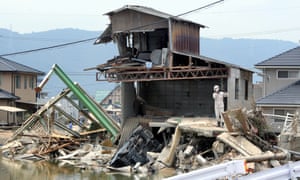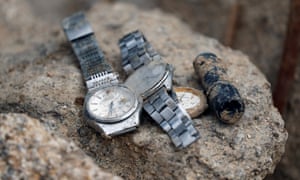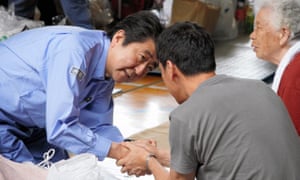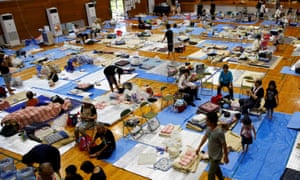begin quote from:
'I saw my house sink': Japan takes stock after deadly rains | World ...
https://www.theguardian.com/.../i-saw-my-house-sink-japan-deadly-rains-search-extre...
17 hours ago - After the waters had receded and the sun finally made an appearance, Ken Kirioka was contemplating the personal cost of the heaviest rainfall ...Videos
Guardian US on Twitter: "'I saw my house sink': Japan takes stock after ...
https://twitter.com/GuardianUS/status/1017594499852271621
14 hours ago - US news, opinion, features and sports from the Guardian. .... 'I saw my house sink'I saw my house sink': Japan takes stock after deadly rains
As search operations continue questions asked about ability to withstand extreme weather
After the waters had receded and the sun finally made an appearance, Ken Kirioka was contemplating the personal cost of the heaviest rainfall Japan has experienced in more than three decades.
Kirioka looked on helplessly as rescue workers dug their way through the mud that had crushed homes in the mountainside town of Kumano in search of the missing, including his 76-year-old father, Katsuharu.
“He is old and has a heart condition,” Kirioka said. “I prepared myself for the worst when I heard about the landslide,” he added, pointing to a pile of mud and rubble where he believed his father had been buried.
Kirioka conceded there was little chance of his father, or anyone else missing, being found alive across a region where the death toll from floods and landslides triggered by days of record rainfall this week has risen to more 200, with about 60 people still unaccounted for.
On Friday, as the prime minister, Shinzō Abe, made his second visit to devastated areas across west and central Japan, the government vowed to quickly rehouse the displaced and begin the long task of rebuilding shattered homes, businesses and infrastructure.
The 7,000 people living in shelters, and 250,000 others whose homes are without water, face a new threat – the arrival of summer heat and humidity.
“We’ll cut through all the bureaucracy to secure the things people need, to improve life in the evacuation centres, such as air conditioners as the hot days continue, and then secure temporary housing and the other items people need to rebuild their lives,” Abe said this week during a visit to a shelter in the town of Kurashiki, where at least 40 people died.
Dressed casually and stopping to kneel and talk to evacuees, he said the government had secured temporary accommodation for people whose homes had been damaged or destroyed and pledged 2.25bn yen (£15m) for the immediate relief effort, and financial support for local authorities as they begin the task of rebuilding devastated populations across central and south-west regions.
More than 700 houses were destroyed or damaged, and more than 23,000 were flooded, according to the fire and disaster management agency.
Television footage of upturned vehicles trapped in mud, homes reduced to rubble and people marooned by muddy water brought to mind the scenes that followed the March 2011 earthquake and tsunami, Japan’s deadliest postwar natural disaster.
While the number of casualties is much lower, the damage is so widespread that reconstruction, like that following the tsunami seven years ago, is expected to take years rather than months.
While 75,000 members of the self-defence forces, fire service, police and coastguard continued the search for survivors and bodies, questions were being asked about Japan’s ability to withstand extreme weather events.
Modern Japanese towns and cities have been built to withstand earthquakesof magnitudes that would cause significant damage and loss of life in other parts of the world, but the floods have exposed serious flaws when it comes to heavy and prolonged rainfall.
The rains are the deadliest weather-related disaster in Japan since two typhoons struck in quick succession in August and September 2011, killing almost 100 people. The death toll is higher than that seen in 2014, when 74 people died in landslides caused by torrential rain in Hiroshima. In 1982 landslides killed more than 300 people in the Nagasaki area.
The government’s leading spokesman, Yoshihide Suga, said Japan had been unprepared, particularly in populated strips of land in mountainous areas, where landslides are a constant threat during heavy rain.
“It’s an undeniable fact that this sort of disaster due to torrential, unprecedented rain is becoming more frequent in recent years,” he said. “We recognise that there’s a need to look into steps we can take to reduce the damage from disasters like this.”
In 2001, municipalities were required to share hazard maps that showed areas considered most vulnerable to flooding and landslides, but many towns and villages were built in those same disaster-prone areas before the maps were drawn up.
Some of this week’s deaths occurred because residents ignored evacuation warnings, either because they had lived through heavy rainfall before or because they had no idea where to go.
On Friday, emergency workers continued to brave the mud and heat, while vehicles carrying clothes, water and other essentials struggled to negotiate badly damaged roads in an attempt to reach isolated communities.
In the Mabi district of Kurashiki, residents took stock of the damage. “I saw my house sink underwater and there was nothing I could do. I felt helpless,” said Fumiko Inokuchi, who fled to safety on the upper floor of a nearby nursing home as she watched water inundate her home.
“I got married here, and we built this house two years later,” the 61-year-old said, fighting back tears as she clutched an old photo of her children playing baseball. “We raised our three sons here ... there are so many memories.”






No comments:
Post a Comment